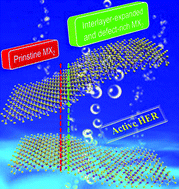Interlayer-expanded and defect-rich metal dichalcogenide (MX2) nanosheets for active and stable hydrogen evolution†
Abstract
Layered metal dichalcogenides (MX2) constructed from 2D covalently bonded monolayers are an exciting family as promising low-cost electrocatalysts towards the hydrogen evolution reaction (HER). Defect engineering of layered lattices to fully utilize MX2 nanosheets is highly desirable. Herein, we report a universal synthesis of defective MX2 nanosheets by modulating both the basal planes and the interlayers. A series of basal plane-disordered and interlayer-expanded MX2 (M = Mo, W, Sn; X = S, Se) nanosheets are synthesized. Interlayer spacings of the MX2 nanosheets are significantly enlarged to 0.93–1.05 nm with an increase of 0.34–0.40 nm, owing to species intercalation. Abundant defects resulting from the wide interlayer expansion and the disordered basal planes offer extensive unsaturated chalcogen atoms as active sites for HER. Consequently, interlayer-expanded and defect-rich (IEDR) MX2 catalysts exhibit striking activities, delivering small Tafel slopes, low onset overpotentials, large cathodic current densities and excellent long-term stabilities. Our work paves a new pathway to improve the electrocatalytic HER activity by defect modulation.



 Please wait while we load your content...
Please wait while we load your content...